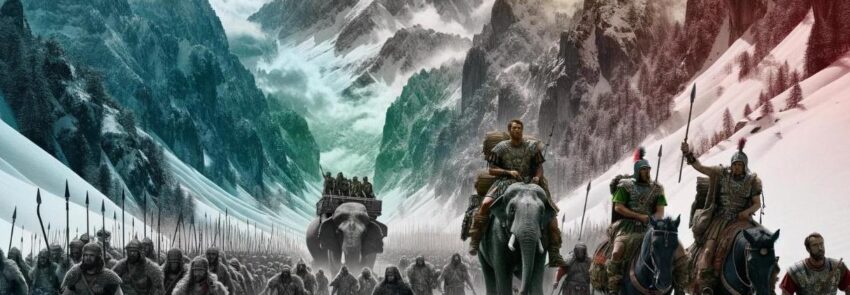The Invasion of Italy
The invasion of Italy by Hannibal during the Second Punic War stands as one of the most audacious military campaigns in ancient history. After securing his position in Spain and amassing a formidable army, Hannibal decided to take the fight to Rome itself. In 218 BCE, he set out on an epic journey that would see him and his army crossing the formidable Alps, a feat that no one had attempted before on such a scale. Hannibal’s army, comprising 50,000 infantry, 9,000 cavalry, and a number of war elephants, faced numerous challenges during the crossing. The harsh alpine environment, with its freezing temperatures and treacherous paths, took a heavy toll on his forces. Additionally, they encountered resistance from various local tribes who were hostile to Hannibal’s presence. Despite these difficulties, Hannibal’s leadership and determination kept the army moving forward.
The crossing of the Alps, which lasted several weeks, cost Hannibal a significant portion of his army. Estimates suggest that he lost nearly half of his men and many of his elephants to the harsh conditions and skirmishes along the way. However, the psychological impact of this achievement was immense. Hannibal’s arrival in Italy with a battle-ready force sent shockwaves through the Roman Republic, which had not anticipated an invasion from the north. Hannibal wasted no time in engaging the Roman forces. His first major encounter with the Romans occurred at the Battle of the Ticinus River, where he successfully deployed his cavalry to secure a victory. This was followed by the Battle of the Trebia River later in 218 BCE, where Hannibal used the terrain and his superior tactics to lure the Roman army into a trap, resulting in a crushing defeat for the Romans.
In 217 BCE, Hannibal continued his campaign with a stunning victory at Lake Trasimene. Exploiting the terrain and the element of surprise, he executed one of the largest ambushes in military history. The Roman army, led by Gaius Flaminius, was caught off guard and annihilated. This victory not only showcased Hannibal’s tactical brilliance but also struck fear into the heart of Rome. After Lake Trasimene, Hannibal adopted a strategy of ravaging the Italian countryside, aiming to break Rome’s alliances with other Italian cities and tribes. His campaign reached its zenith in 216 BCE at the Battle of Cannae, where Hannibal achieved his most famous and decisive victory. Employing a double-envelopment tactic, he encircled and destroyed a much larger Roman force. The Romans suffered catastrophic losses, with tens of thousands of soldiers killed or captured. The Battle of Cannae is often cited as one of the greatest tactical feats in military history, demonstrating Hannibal’s strategic genius and ability to adapt to different battlefield conditions.
Following Cannae, Hannibal aimed to capitalize on his victories by encouraging defections among Rome’s allies and applying continuous pressure on the Roman forces. However, despite his battlefield successes, he faced significant logistical challenges. Securing adequate supplies and reinforcements from Carthage proved difficult, as the Carthaginian leadership was reluctant to fully commit to the war effort. Moreover, while many of the Italian states were impressed by his victories, they were hesitant to fully support him against Rome. As the war dragged on, the Romans adapted to Hannibal’s tactics. Under the cautious and methodical leadership of generals like Fabius Maximus, they avoided direct confrontations and adopted a strategy of attrition, gradually weakening Hannibal’s forces. This prolonged campaign in Italy strained Hannibal’s resources and tested the resilience of his army. The first half of Hannibal’s campaign in Italy thus highlights his extraordinary tactical skill and the profound impact he had on the course of the Second Punic War. Despite the challenges, Hannibal’s audacious strategies and battlefield ingenuity remain a testament to his military prowess and enduring legacy.
 |
 |
 |


